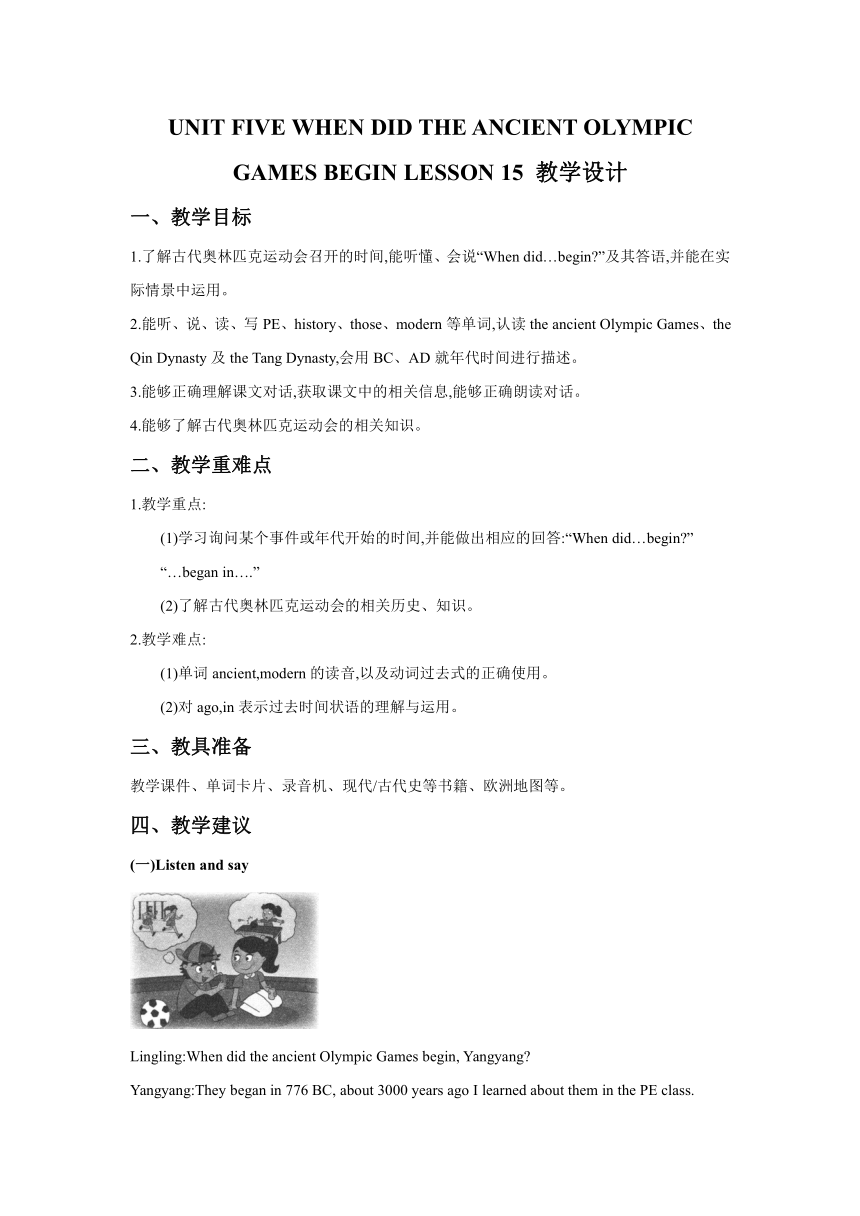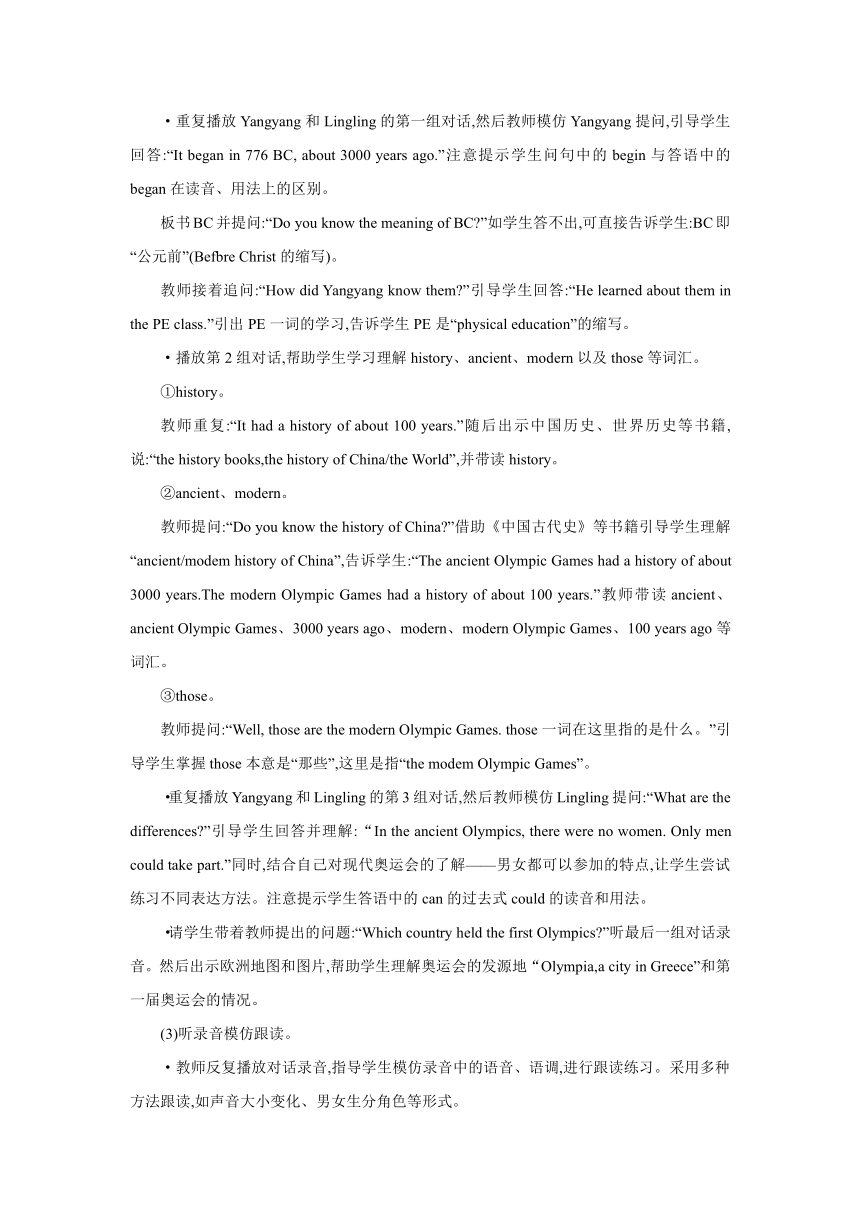Unit 5 When did the ancient Olympic Games begin Lesson 15 教学设计
文档属性
| 名称 | Unit 5 When did the ancient Olympic Games begin Lesson 15 教学设计 |  | |
| 格式 | zip | ||
| 文件大小 | 166.7KB | ||
| 资源类型 | 教案 | ||
| 版本资源 | 北京版 | ||
| 科目 | 英语 | ||
| 更新时间 | 2018-06-13 15:36:35 | ||
图片预览



文档简介
UNIT FIVE WHEN DID THE ANCIENT OLYMPIC GAMES BEGIN LESSON 15 教学设计
一、教学目标
1.了解古代奥林匹克运动会召开的时间,能听懂、会说“When did…begin?”及其答语,并能在实际情景中运用。
2.能听、说、读、写PE、history、those、modern等单词,认读the ancient Olympic Games、the Qin Dynasty及the Tang Dynasty,会用BC、AD就年代时间进行描述。
3.能够正确理解课文对话,获取课文中的相关信息,能够正确朗读对话。
4.能够了解古代奥林匹克运动会的相关知识。
二、教学重难点
1.教学重点:
(1)学习询问某个事件或年代开始的时间,并能做出相应的回答:“When did…begin?”
“…began in….”
(2)了解古代奥林匹克运动会的相关历史、知识。
2.教学难点:
(1)单词ancient,modern的读音,以及动词过去式的正确使用。
(2)对ago,in表示过去时间状语的理解与运用。
三、教具准备
教学课件、单词卡片、录音机、现代/古代史等书籍、欧洲地图等。
四、教学建议
(一)Listen and say
Lingling:When did the ancient Olympic Games begin, Yangyang?
Yangyang:They began in 776 BC, about 3000 years ago I learned about them in the PE class.
Lingling: Really? I thought they had a history of only about 100 years.
Yangyang: Well, those are the modem Olympic Games They are different from the ancient ones.
Lingling: Whet are the differences?
Yangyang: Well, in the ancient Olympics, there were no women Only men could take part.
Lingling: That wasn't fair! Which country held the first Olympics?
Yangyang: Greece The Games were haid in Olympia, a city in Creece.
分析与提示
·本部分内容主要是通过情景对话使学生了解古代奥林匹克运动会的历史,学习要求掌握的句型及词语,认读、运用began、thought、held等不规则动词的过去式,同时教师还要注意指导学生掌握数字3000等的读法和年份的读法等。本部分重点是在课堂操练和具体情景中应用交际用语。教师要通过意义操练,帮助学生理解和掌握所学语言。
1.导入
(1)创设情景学习begin一词,对学生说:“Let's begin our English class.”
(2)然后以提问的方式导入本课的学习。如,教师提问:
·Do you have PE today?
·Do you like sports?
·What's our favourite sport?
·Do you know the Olympic Games?
·Can you say something about the Olympic Games?
·Do you know the ancient Olympic Games?
提示学生:“the ancient Olympic Games”即古代奥林匹克运动会。
2.学习对话
(1)认识图中人物。
·教师出示并引导学生观察主题图,逐一指着图中的人物提问:“Who's she? Who's he?”引导学生说出:“She's Lingling. He's Yangyang.”了解图中人物。
·请学生继续观察图片,并提问:“Where are they?”学生会说:“In the playground.”教师继续提问:“What are they talking about? Can you guess?”学生猜测答案。教师带着学生听对话录音。
(2)初听理解对话。
·播放对话录音两遍,请学生听一听对话谈论的话题:“What are they talking about?”然后说一说听懂的词语及对话的大概内容。
·重复播放Yangyang和Lingling的第一组对话,然后教师模仿Yangyang提问,引导学生回答:“It began in 776 BC, about 3000 years ago.”注意提示学生问句中的begin与答语中的began在读音、用法上的区别。
板书BC并提问:“Do you know the meaning of BC?”如学生答不出,可直接告诉学生:BC即“公元前”(Befbre Christ的缩写)。
教师接着追问:“How did Yangyang know them?”引导学生回答:“He learned about them in the PE class.”引出PE一词的学习,告诉学生PE是“physical education”的缩写。
·播放第2组对话,帮助学生学习理解history、ancient、modern以及those等词汇。
①history。
教师重复:“It had a history of about 100 years.”随后出示中国历史、世界历史等书籍,说:“the history books,the history of China/the World”,并带读history。
②ancient、modern。
教师提问:“Do you know the history of China?”借助《中国古代史》等书籍引导学生理解“ancient/modem history of China”,告诉学生:“The ancient Olympic Games had a history of about 3000 years.The modern Olympic Games had a history of about 100 years.”教师带读ancient、ancient Olympic Games、3000 years ago、modern、modern Olympic Games、100 years ago等词汇。
③those。
教师提问:“Well, those are the modern Olympic Games. those一词在这里指的是什么。”引导学生掌握those本意是“那些”,这里是指“the modem Olympic Games”。
·重复播放Yangyang和Lingling的第3组对话,然后教师模仿Lingling提问:“What are the differences?”引导学生回答并理解:“In the ancient Olympics, there were no women. Only men could take part.”同时,结合自己对现代奥运会的了解——男女都可以参加的特点,让学生尝试练习不同表达方法。注意提示学生答语中的can的过去式could的读音和用法。
·请学生带着教师提出的问题:“Which country held the first Olympics?”听最后一组对话录音。然后出示欧洲地图和图片,帮助学生理解奥运会的发源地“Olympia,a city in Greece”和第一届奥运会的情况。
(3)听录音模仿跟读。
·教师反复播放对话录音,指导学生模仿录音中的语音、语调,进行跟读练习。采用多种方法跟读,如声音大小变化、男女生分角色等形式。
(4)角色扮演。
·教师利用PPT创设情景,教师和学生分别扮演Lingling和Yangyang,示范表演对话。
·小组活动:朗读或表演对话,并进行展示。
(二)Listen,look,and learn
分析与提示
·本部分内容主要是学习询问某届奥运会或某个朝代开始时间的交际用语“When did…begin?…began in…in….”为学生提供了古奥运会等三幅图片和其对应的英文表达the ancient Olympic Games、Qin Dynasty、the Tang Dynasty及其开始的时间供学生认读。练习运用这些词语仿照例句开展言语活动,达到熟练运用所学句型的目的。
1.词句学习
(1)教师出示古代奥林匹克运动会的图片,然后提问:“When did the ancient Olympic Games begin?”引导学生说出:“They began in 776 BC.”
(2)教师出示秦代兵马俑、唐朝人物等图片,请学生观察图片,猜出朝代,并学习英文表达。
(3)请学生边看书中的图片边听录音,跟读图下面的单词和短语。
(4)提示学生注意,BC与AD表达时间的不同,即BC表示“公元前”(Before Christ的缩写)。“公元”常以AD表示(拉丁文Anno Domini的缩写)。
(5)开展team work,朗读图旁的朝代和年份,按年份的正确表达朗读,如:seven hundred and seventy-six BC, two hundredand twenty-one BC, six hundred and eighteen AD。记忆单词dy-nasty。
2.巩固练习
(1)请学生阅读例句:“When did the ancient Olympic Games begin?”“They began in 776 BC.”注意句中的黑体字部分。
(2)请学生用所给朝代及其年份替换句中的黑体字部分。如:
When did the Qin Dynasty/the Tang Dynasty begin?
It began in....
选择灵活的方式提示学生,在做替换练习时要注意句子的主谓一致。
3.拓展运用
开展pair work,请学生创设情景,用所学交际用语展开情景对话。教师巡视指导,请准备好的学生在全班表演对话。
(三)Listen and match
分析与提示
·本部分内容为学生提供了根据所听内容,将图片与日期连线的练习。培养学生的听力、理解力和判断力。本练习的难度不大,可采用检测的方式由学生独立完成。
(1)请学生认真观察五幅图片,了解图片内容,做好听录音的准备。
(2)播放录音,播三遍。第l遍请学生认真听,第2遍请学生根据所听内容,将相应的图片与日历上的日期连线。第3遍,再听录音检查自己的答案。
(3)组织学生订正答案。
(4)请学生看所连线的图片,跟读录音,注意语音、语调。
(四)Let's do
Discuss and write down the differences between the ancient and the modern Olympics
Ancient Olympics
Modern Olympics
0nly men could
Both men and women carl
分析与提示
·本部分内容旨在让学生根据所学奥运会历史知识,小组展开讨论,对比古代奥运会和现代奥运会的不同。学生还可以通过网络查找更多奥运会知识,更好地完成表格内容。
(1)教师出示表格,全班同学围绕表格中的Ancient Olym-pics和Modern Olympics两个内容进行头脑风暴,说出自己知道的尽可能多的信息,复习巩同所学的与奥运会相关的词语和句子。
(2)教师布置任务:“Discuss and write down the differences between the ancient and modern Olympics.”引导学生根据课文所学内容和自己所知道的奥运会的相关信息完成任务。
(3)Pair work:学生自主讨论,根据自己的了解对比古代奥运会与现代奥运会的不同。
(4)请学生以小组为单位,向全班展示自己小组完成的表格。例如:
Ancient Olympics
Modern Olympics
Only men could...
Both men and women can...
Began in 776BC
Began in l896
In Olympia
In Athens
...
...
(5)评一评:谁表达得准确,表达流利,语音语调标准,信息点丰富。
五、可供选择的教学活动
1.读一读。记一记
目的:通过朗读词语,进一步理解、记忆词义,提高运用词语描述的准确性。
步骤:
(1)教师出示词语。如:A. 3000/100 years B. ancient/modern Olympic Games C. hundred/thousand D. ...
(2)请学生抢答认读,然后开展自主认读,练习用词说句子。
2.Brain Storming
目的:复习有关所学词语,强化单词记忆,锻炼学生的思维能力。
步骤:
(1)教师在黑板上画一个圆形思维图,在中间板书主题The Ancient Olympic Games,请学生以小组为单位在圆圈中写出与这一主题相关的其他单词或短语(也可以在纸上完成)。(见下图)
(2)学生朗读写出的单词,哪个小组写出的数量多且正确,哪组获胜。
(3)请学生根据思维图,梳理信息点,围绕主题,尝试用句子连贯地表达,说一段话,介绍古代奥运会,锻炼学生的语言表达能力和思维能力。
一、教学目标
1.了解古代奥林匹克运动会召开的时间,能听懂、会说“When did…begin?”及其答语,并能在实际情景中运用。
2.能听、说、读、写PE、history、those、modern等单词,认读the ancient Olympic Games、the Qin Dynasty及the Tang Dynasty,会用BC、AD就年代时间进行描述。
3.能够正确理解课文对话,获取课文中的相关信息,能够正确朗读对话。
4.能够了解古代奥林匹克运动会的相关知识。
二、教学重难点
1.教学重点:
(1)学习询问某个事件或年代开始的时间,并能做出相应的回答:“When did…begin?”
“…began in….”
(2)了解古代奥林匹克运动会的相关历史、知识。
2.教学难点:
(1)单词ancient,modern的读音,以及动词过去式的正确使用。
(2)对ago,in表示过去时间状语的理解与运用。
三、教具准备
教学课件、单词卡片、录音机、现代/古代史等书籍、欧洲地图等。
四、教学建议
(一)Listen and say
Lingling:When did the ancient Olympic Games begin, Yangyang?
Yangyang:They began in 776 BC, about 3000 years ago I learned about them in the PE class.
Lingling: Really? I thought they had a history of only about 100 years.
Yangyang: Well, those are the modem Olympic Games They are different from the ancient ones.
Lingling: Whet are the differences?
Yangyang: Well, in the ancient Olympics, there were no women Only men could take part.
Lingling: That wasn't fair! Which country held the first Olympics?
Yangyang: Greece The Games were haid in Olympia, a city in Creece.
分析与提示
·本部分内容主要是通过情景对话使学生了解古代奥林匹克运动会的历史,学习要求掌握的句型及词语,认读、运用began、thought、held等不规则动词的过去式,同时教师还要注意指导学生掌握数字3000等的读法和年份的读法等。本部分重点是在课堂操练和具体情景中应用交际用语。教师要通过意义操练,帮助学生理解和掌握所学语言。
1.导入
(1)创设情景学习begin一词,对学生说:“Let's begin our English class.”
(2)然后以提问的方式导入本课的学习。如,教师提问:
·Do you have PE today?
·Do you like sports?
·What's our favourite sport?
·Do you know the Olympic Games?
·Can you say something about the Olympic Games?
·Do you know the ancient Olympic Games?
提示学生:“the ancient Olympic Games”即古代奥林匹克运动会。
2.学习对话
(1)认识图中人物。
·教师出示并引导学生观察主题图,逐一指着图中的人物提问:“Who's she? Who's he?”引导学生说出:“She's Lingling. He's Yangyang.”了解图中人物。
·请学生继续观察图片,并提问:“Where are they?”学生会说:“In the playground.”教师继续提问:“What are they talking about? Can you guess?”学生猜测答案。教师带着学生听对话录音。
(2)初听理解对话。
·播放对话录音两遍,请学生听一听对话谈论的话题:“What are they talking about?”然后说一说听懂的词语及对话的大概内容。
·重复播放Yangyang和Lingling的第一组对话,然后教师模仿Yangyang提问,引导学生回答:“It began in 776 BC, about 3000 years ago.”注意提示学生问句中的begin与答语中的began在读音、用法上的区别。
板书BC并提问:“Do you know the meaning of BC?”如学生答不出,可直接告诉学生:BC即“公元前”(Befbre Christ的缩写)。
教师接着追问:“How did Yangyang know them?”引导学生回答:“He learned about them in the PE class.”引出PE一词的学习,告诉学生PE是“physical education”的缩写。
·播放第2组对话,帮助学生学习理解history、ancient、modern以及those等词汇。
①history。
教师重复:“It had a history of about 100 years.”随后出示中国历史、世界历史等书籍,说:“the history books,the history of China/the World”,并带读history。
②ancient、modern。
教师提问:“Do you know the history of China?”借助《中国古代史》等书籍引导学生理解“ancient/modem history of China”,告诉学生:“The ancient Olympic Games had a history of about 3000 years.The modern Olympic Games had a history of about 100 years.”教师带读ancient、ancient Olympic Games、3000 years ago、modern、modern Olympic Games、100 years ago等词汇。
③those。
教师提问:“Well, those are the modern Olympic Games. those一词在这里指的是什么。”引导学生掌握those本意是“那些”,这里是指“the modem Olympic Games”。
·重复播放Yangyang和Lingling的第3组对话,然后教师模仿Lingling提问:“What are the differences?”引导学生回答并理解:“In the ancient Olympics, there were no women. Only men could take part.”同时,结合自己对现代奥运会的了解——男女都可以参加的特点,让学生尝试练习不同表达方法。注意提示学生答语中的can的过去式could的读音和用法。
·请学生带着教师提出的问题:“Which country held the first Olympics?”听最后一组对话录音。然后出示欧洲地图和图片,帮助学生理解奥运会的发源地“Olympia,a city in Greece”和第一届奥运会的情况。
(3)听录音模仿跟读。
·教师反复播放对话录音,指导学生模仿录音中的语音、语调,进行跟读练习。采用多种方法跟读,如声音大小变化、男女生分角色等形式。
(4)角色扮演。
·教师利用PPT创设情景,教师和学生分别扮演Lingling和Yangyang,示范表演对话。
·小组活动:朗读或表演对话,并进行展示。
(二)Listen,look,and learn
分析与提示
·本部分内容主要是学习询问某届奥运会或某个朝代开始时间的交际用语“When did…begin?…began in…in….”为学生提供了古奥运会等三幅图片和其对应的英文表达the ancient Olympic Games、Qin Dynasty、the Tang Dynasty及其开始的时间供学生认读。练习运用这些词语仿照例句开展言语活动,达到熟练运用所学句型的目的。
1.词句学习
(1)教师出示古代奥林匹克运动会的图片,然后提问:“When did the ancient Olympic Games begin?”引导学生说出:“They began in 776 BC.”
(2)教师出示秦代兵马俑、唐朝人物等图片,请学生观察图片,猜出朝代,并学习英文表达。
(3)请学生边看书中的图片边听录音,跟读图下面的单词和短语。
(4)提示学生注意,BC与AD表达时间的不同,即BC表示“公元前”(Before Christ的缩写)。“公元”常以AD表示(拉丁文Anno Domini的缩写)。
(5)开展team work,朗读图旁的朝代和年份,按年份的正确表达朗读,如:seven hundred and seventy-six BC, two hundredand twenty-one BC, six hundred and eighteen AD。记忆单词dy-nasty。
2.巩固练习
(1)请学生阅读例句:“When did the ancient Olympic Games begin?”“They began in 776 BC.”注意句中的黑体字部分。
(2)请学生用所给朝代及其年份替换句中的黑体字部分。如:
When did the Qin Dynasty/the Tang Dynasty begin?
It began in....
选择灵活的方式提示学生,在做替换练习时要注意句子的主谓一致。
3.拓展运用
开展pair work,请学生创设情景,用所学交际用语展开情景对话。教师巡视指导,请准备好的学生在全班表演对话。
(三)Listen and match
分析与提示
·本部分内容为学生提供了根据所听内容,将图片与日期连线的练习。培养学生的听力、理解力和判断力。本练习的难度不大,可采用检测的方式由学生独立完成。
(1)请学生认真观察五幅图片,了解图片内容,做好听录音的准备。
(2)播放录音,播三遍。第l遍请学生认真听,第2遍请学生根据所听内容,将相应的图片与日历上的日期连线。第3遍,再听录音检查自己的答案。
(3)组织学生订正答案。
(4)请学生看所连线的图片,跟读录音,注意语音、语调。
(四)Let's do
Discuss and write down the differences between the ancient and the modern Olympics
Ancient Olympics
Modern Olympics
0nly men could
Both men and women carl
分析与提示
·本部分内容旨在让学生根据所学奥运会历史知识,小组展开讨论,对比古代奥运会和现代奥运会的不同。学生还可以通过网络查找更多奥运会知识,更好地完成表格内容。
(1)教师出示表格,全班同学围绕表格中的Ancient Olym-pics和Modern Olympics两个内容进行头脑风暴,说出自己知道的尽可能多的信息,复习巩同所学的与奥运会相关的词语和句子。
(2)教师布置任务:“Discuss and write down the differences between the ancient and modern Olympics.”引导学生根据课文所学内容和自己所知道的奥运会的相关信息完成任务。
(3)Pair work:学生自主讨论,根据自己的了解对比古代奥运会与现代奥运会的不同。
(4)请学生以小组为单位,向全班展示自己小组完成的表格。例如:
Ancient Olympics
Modern Olympics
Only men could...
Both men and women can...
Began in 776BC
Began in l896
In Olympia
In Athens
...
...
(5)评一评:谁表达得准确,表达流利,语音语调标准,信息点丰富。
五、可供选择的教学活动
1.读一读。记一记
目的:通过朗读词语,进一步理解、记忆词义,提高运用词语描述的准确性。
步骤:
(1)教师出示词语。如:A. 3000/100 years B. ancient/modern Olympic Games C. hundred/thousand D. ...
(2)请学生抢答认读,然后开展自主认读,练习用词说句子。
2.Brain Storming
目的:复习有关所学词语,强化单词记忆,锻炼学生的思维能力。
步骤:
(1)教师在黑板上画一个圆形思维图,在中间板书主题The Ancient Olympic Games,请学生以小组为单位在圆圈中写出与这一主题相关的其他单词或短语(也可以在纸上完成)。(见下图)
(2)学生朗读写出的单词,哪个小组写出的数量多且正确,哪组获胜。
(3)请学生根据思维图,梳理信息点,围绕主题,尝试用句子连贯地表达,说一段话,介绍古代奥运会,锻炼学生的语言表达能力和思维能力。
同课章节目录
- Unit 1 What did you do this summer?
- Lesson 1
- Lesson 2
- Lesson 3
- Lesson 4
- Unit 2 What happened to your neck?
- Lesson 5
- Lesson 6
- Lesson 7
- Lesson 8
- Unit 3 How did you go to Hangzhou?
- Lesson 9
- Lesson 10
- Lesson 11
- Lesson 12
- Unit 4 Revision
- Lesson 13
- Lesson 14
- Unit 5 When did the ancient Olympic Games begin?
- Lesson 15
- Lesson 16
- Lesson 17
- Lesson 18
- Unit 6 What is he wearing?
- Lesson 19
- Lesson 20
- Lesson 21
- Lesson 22
- Unit 7 What are the twelve animals?
- Lesson 23
- Lesson 24
- Lesson 25
- Lesson 26
- Unit 8 Revision
- Lesson 27
- Lesson 28
